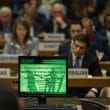What’s the difference between prohibited and permitted chemical agents?
By Ralf Trapp |
The title of Jonathan Tucker's article could easily have been "the body's own chemical weapons." I'm making this point to highlight the convergence between biology and chemistry–a development whose implications for arms control needs further study. The emergence of new chemicals that interfere with brain functions or other regulatory processes in humans (such as bioregulators and neuroactive peptides) is a key feature of this crossover.
Military interest in this type of toxic chemicals is not new; what is new is the scientific potential opened up by the biological revolution, combined with advances in engineering and information technology. Scientists' expanding understanding of biological systems combines with advances in particle engineering and the promises of nanotechnology for the development of "smart" delivery systems to carry biologically active chemicals to specific target organs or receptors. The synthesis of complex molecules of biological origin including peptides has also become much easier than in the past.
At the same time, the demand side is evolving, with military requirements adapting to the changing nature of warfare. So-called nonlethal weapons are drawing attention, and scientists are assessing incapacitating chemicals that interfere with human body functions and should have pharmacological safety margins sufficient to avoid killing the target population. To be clear, scientists debate whether it is possible to develop chemical or biological agents that can satisfy the requirement of "non-lethality." (See this recent British Medical Association report). But this discussion misses an important point: The mere fact that there may be an agent that may satisfy the requirements to an extent that may be judged acceptable could suffice to stimulate research and development of new incapacitating agents.
The implications for the Biological and Toxin Weapons Convention (BWC) and the Chemical Weapons Convention (CWC) could be serious. Both treaties approach the weapons they ban in a comprehensive manner, defining the purpose (intent) of using an agent for weapons purposes as the criterion for deciding whether a chemical or biological material is a prohibited weapon or a legitimate material. That consideration also applies to incapacitants. Contrary to Tucker's argument, the status of incapacitants under the CWC is far from ambiguous; or rather, if their status was ambiguous, the status of any toxic chemical, whether lethal or incapacitating, would be, too.
The CWC has some contradictions, though. It allows toxic chemicals to be used for law enforcement purposes, including domestic riot control. Yet, it unequivocally bans the development, acquisition, stockpiling, and use of chemical weapons. Is it possible to distinguish whether a toxic chemical or a delivery system are intended solely for law enforcement purposes and not as a new chemical weapon? What features, characteristics, and parameters would be consistent with law enforcement, and which stipulate chemical weapons? Neither question has a simple answer. Restrictive interpretations of the convention limit the law-enforcement clause to a state's rights to use certain toxic chemicals for domestic riot control; liberal interpretations accept a range of possible uses of any toxic chemical under a state's jurisdiction but call for voluntary declarations to enhance transparency.
Tucker suggests that States Parties should limit the types and quantities of toxic chemicals that they stockpile for law enforcement purposes. He also proposes ways to modify the CWC's verification system to take account of the risks associated with bioregulators. In my view, before one can address the second proposal, there needs to be a common answer to the first one. CWC States Parties have so far failed to discuss the use of incapacitants for law enforcement purposes–this question was in the "too-difficult" category. Expecting the upcoming CWC Review Conference to resolve this issue would be setting it up for failure.
Scientists and policy makers have publicly debated many of the issues related to the use of incapacitants for law enforcement purposes, and States Parties should initiate a thorough discussion of the matter at the state level. This discussion should aim to clarify the demarcations between legitimate developments and prohibited activities. Such a discussion would also help to understand possible verification requirements for the crossover between chemistry and biology. In Julian Perry Robinson's words, the creeping legitimization of incapacitants would lead to a new generation of psychochemical weapons. If ignored, this issue could weaken the fabric of the CWC and open the door for a resurgence of chemical warfare of a new kind.
















